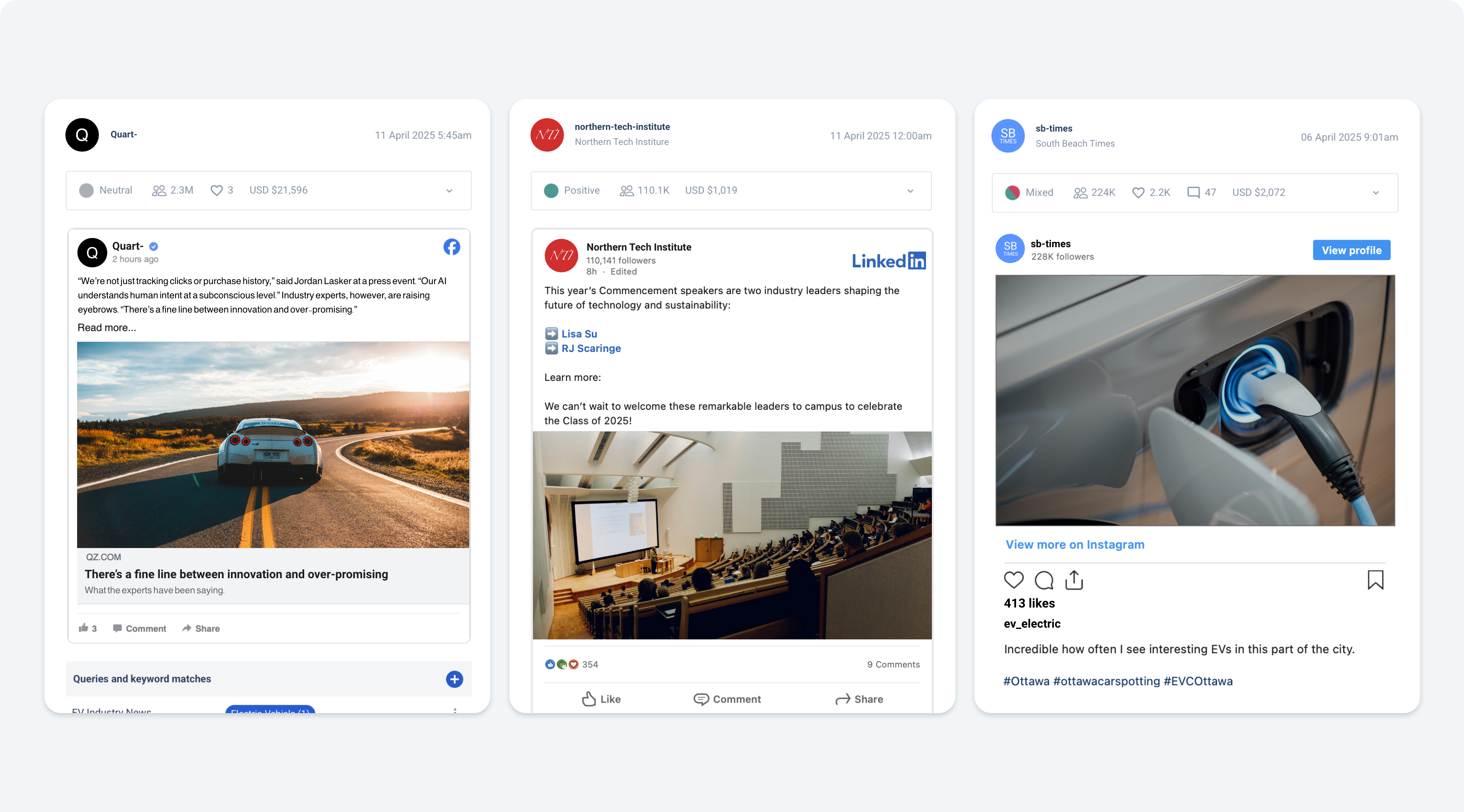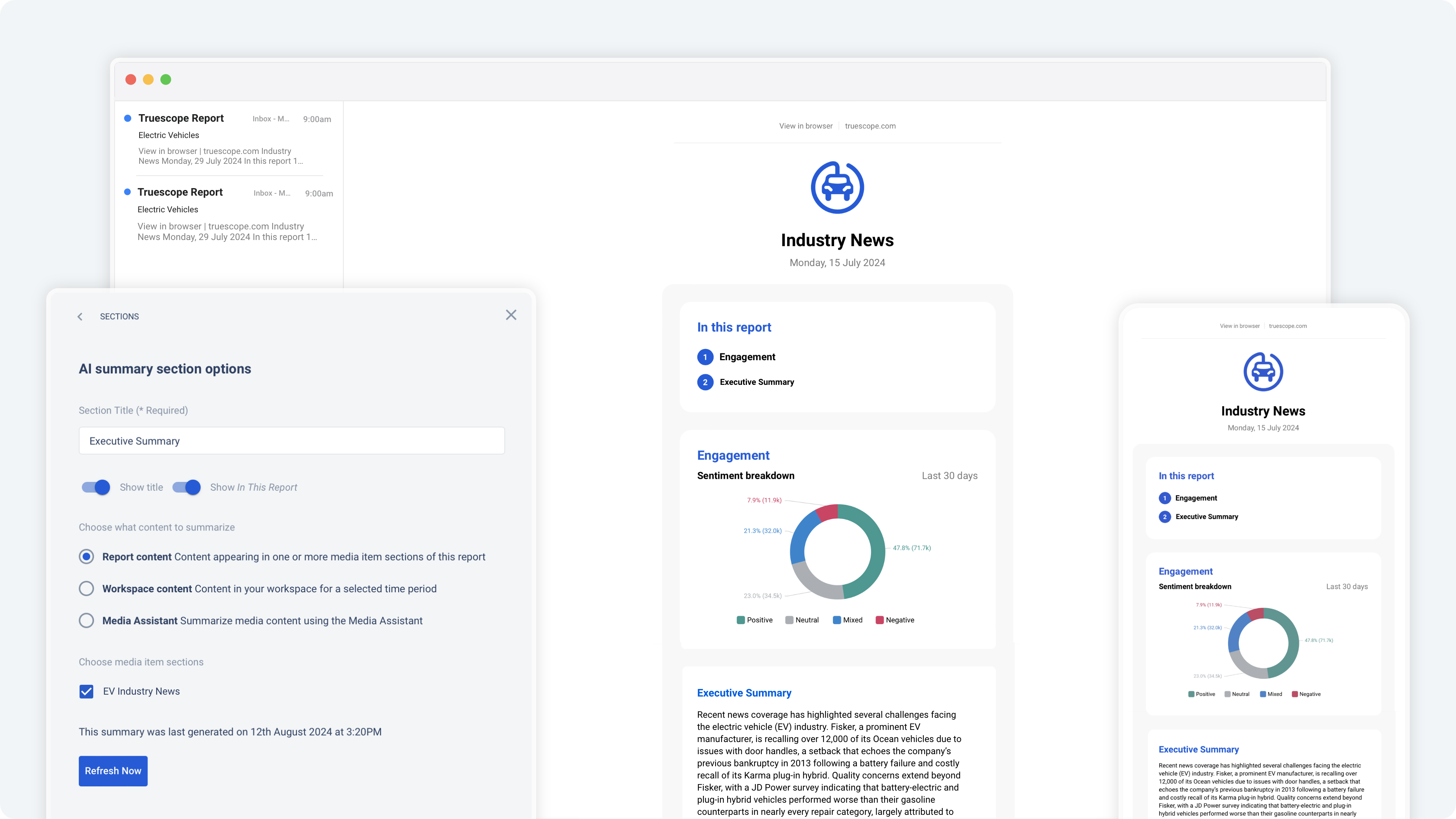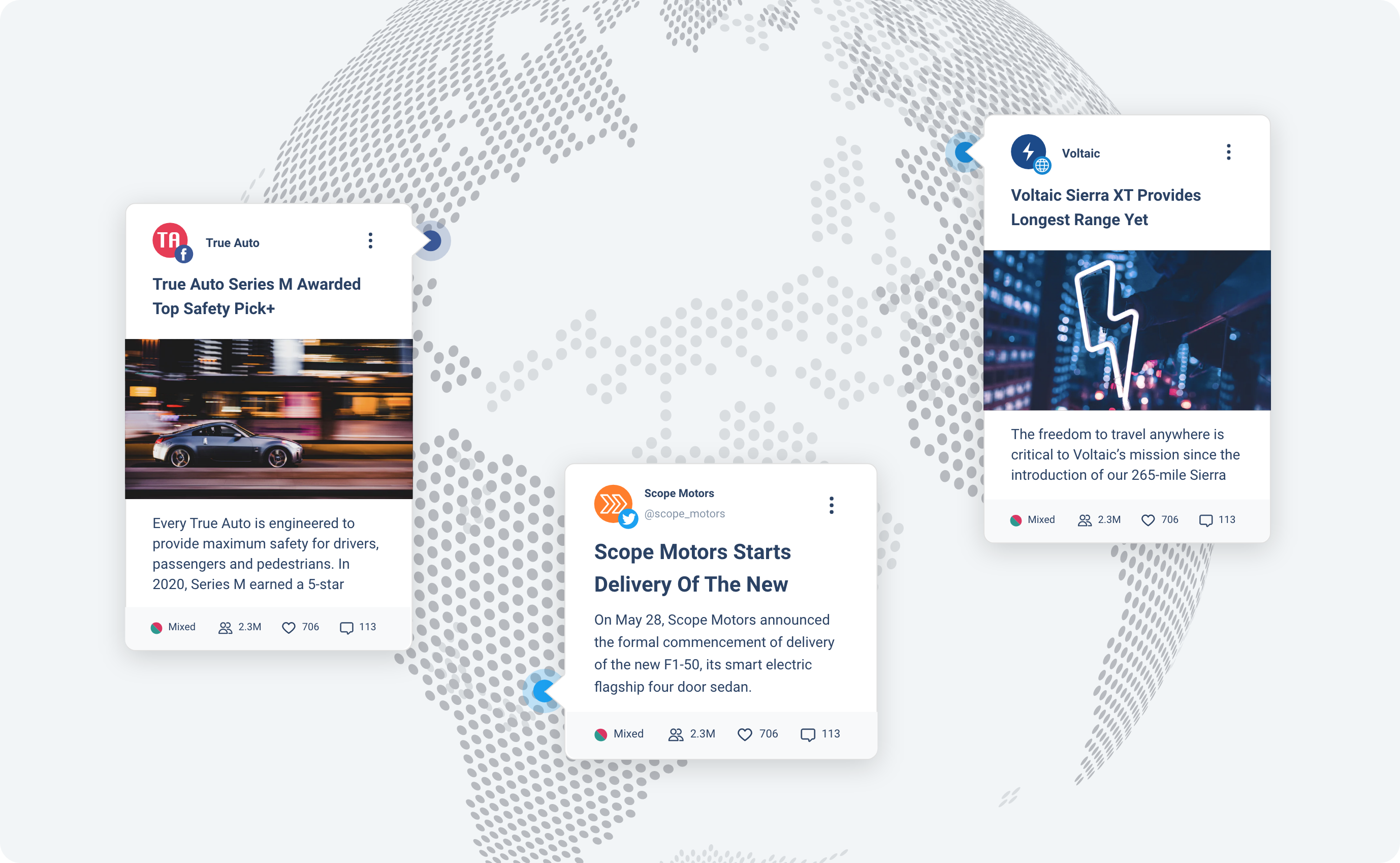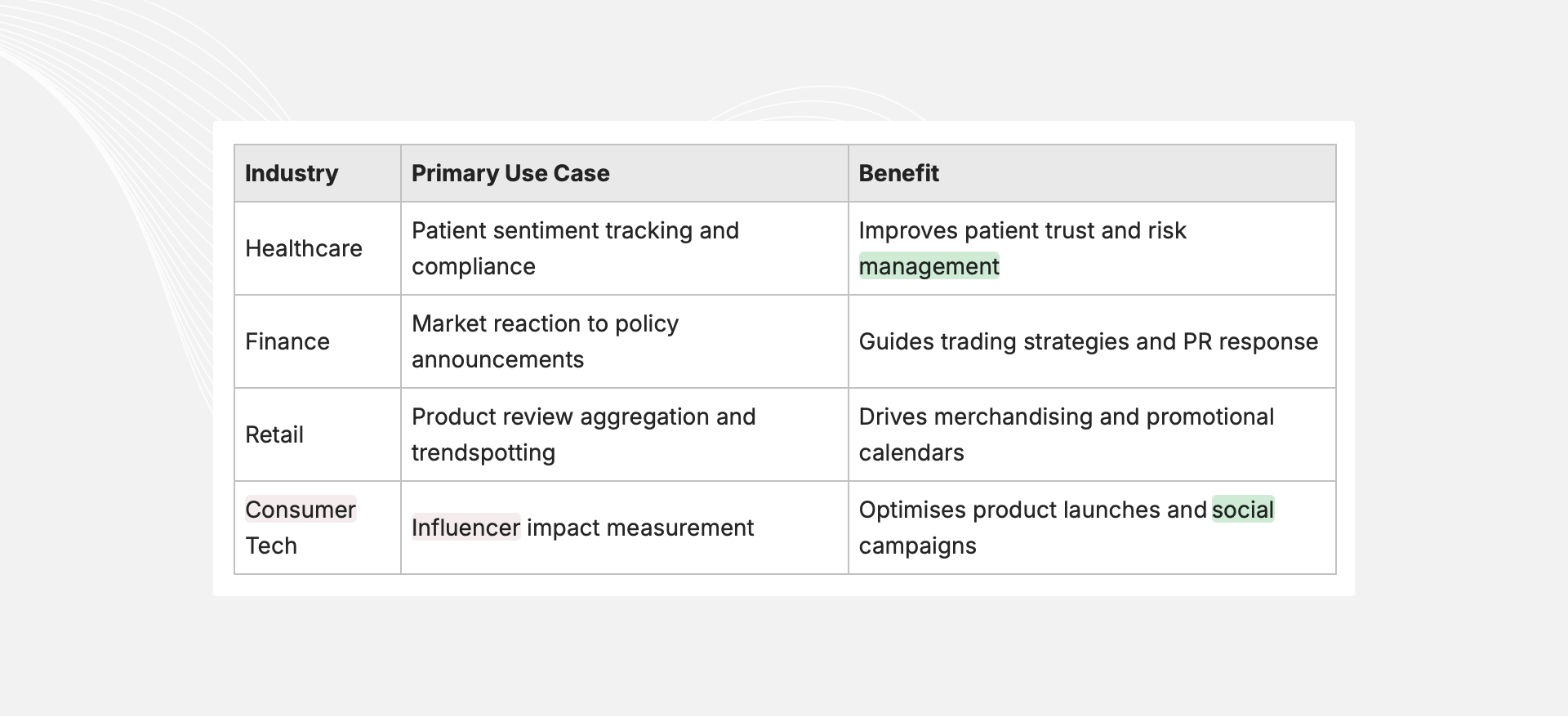Media Intelligence Platforms: Comprehensive Guide to Tools, Benefits, and Applications


Media intelligence platforms provide comprehensive insight by collecting and analysing data from news outlets, social channels, blogs and forums to empower businesses with actionable insights, proactive crisis management and competitive edge. In this guide you will discover what media intelligence is, how AI and NLP drive precision, which monitoring tools lead the market, how brand sentiment analysis bolsters reputation, why social listening is essential, how PR analytics quantify ROI, how competitive intelligence shapes strategy and how various industries integrate these capabilities. Each section answers a core question, offers mechanisms and real-world benefits, and highlights key features that inform platform selection and implementation.

What Is Media Intelligence and Why Does It Matter?
Media intelligence is the process of aggregating, processing and interpreting media data to reveal trends, public sentiment and emerging threats, enabling organisations to make data-driven decisions and protect brand reputation. By leveraging AI-driven entity extraction and sentiment algorithms, platforms transform unstructured text into structured insights that guide marketing, PR and strategic planning. Businesses gain early warning on crises, measure campaign impact and monitor competitive moves in real time.
Media intelligence matters because it drives evidence-based strategies, safeguards public perception and identifies market opportunities before they escalate into crises. Organisations that adopt these platforms report up to 30 percent faster response to negative mentions and a 20 percent lift in marketing ROI through precise audience targeting.
How Does Media Intelligence Collect and Analyse Data?
Media intelligence platforms ingest data from online news sites, broadcast transcripts, social networks and niche forums, then apply automated crawlers and APIs to ensure broad coverage. Natural Language Processing (NLP) parses sentiment, entities and topics, while machine learning models classify relevance and predict trend trajectories.
Data flows through pipelines that normalise formats, tag metadata (source, date, location) and store insights in custom dashboards. Advanced systems enrich raw mentions with contextual markers—tone, region, influencer authority—to enable nuanced analysis and reporting that support decision-making at scale.
What Are the Key Benefits of Media Intelligence for Businesses?
Media intelligence delivers four primary benefits:
- Actionable Insights – Real-time trend tracking uncovers consumer preferences and emerging issues.
- Crisis Management – Early detection of negative threads triggers alerts for swift response.
- Competitive Benchmarking – Share-of-voice analysis and sentiment comparison reveal market position.
- ROI Measurement – Quantified mention reach and engagement metrics evaluate campaign effectiveness.
These benefits reduce reputational risk, sharpen marketing tactics and align communications with audience expectations, laying the groundwork for measurable growth.
How Do AI, NLP, and Machine Learning Enhance Media Intelligence?
AI and NLP transform unstructured media data into precise sentiment scores and entity relationships, enabling automatic classification of topics, detection of sarcasm and differentiation between brand and competitor mentions. Machine learning models learn patterns from historical data to predict emerging trends and quantify earned media value, boosting accuracy and speed over manual methods.
These technologies continuously refine algorithms through feedback loops, improving the relevance of alerts and recommendations. The result is a smarter system that highlights critical insights and filters noise, ensuring teams focus on high-priority developments.
What Are the Future Trends in Media Intelligence?
The media intelligence market is evolving toward predictive analytics, deeper integration with CRM and marketing automation, and real-time visual analytics. By 2026, voice-to-text monitoring for podcasts and live streams will become standard, and federated learning will enable privacy-compliant AI models. Expect hyper-local sentiment mapping, ambient listening for video content and advanced influencer scoring based on network impact. These trends will drive richer context scoring and more proactive, data-driven strategy formulation.
Leading media monitoring software unify broad source coverage, real-time alerts and sentiment integration to offer an end-to-end solution for brand tracking and competitive analysis. Platforms vary in depth of AI analytics, customisable dashboards and pricing models, guiding businesses to select tools that align with their scale and industry needs.
What Features Define Effective Media Monitoring Tools?
Effective media monitoring tools share five core features:
- Comprehensive Source Coverage ensures no mention is missed, spanning news wires, social networks and podcasts.
- Real-Time Alerts notify stakeholders immediately upon threshold breaches or spikes in negative sentiment.
- Sentiment Integration assigns positive, neutral or negative scores to each mention for swift reputation assessment.
- Customisable Dashboards allow users to visualise metrics that matter most to their objectives.
- Scalable API Access supports automated workflows and integration with CRM or BI platforms.
These features collectively empower teams to detect trends, manage crises and demonstrate ROI with clarity.
How Is Real-Time Media Monitoring Used Across Industries?
Real-time media monitoring drives use cases in:
- Healthcare for tracking patient feedback and regulatory mentions.
- Finance for spotting market reactions to policy changes.
- Retail for capturing product reviews and social trends.
In each sector, immediate awareness of mentions informs rapid response, product adjustments and targeted communications, ensuring brands stay ahead of narrative shifts.
What Criteria Should You Use to Choose Media Monitoring Software?
When selecting monitoring software, evaluate:
- Source Breadth – Does it cover the channels critical to your brand?
- Analytical Depth – Are AI-driven insights and predictive features included?
- Integration Capability – Can it connect with existing CRM, marketing automation and BI tools?
- User Experience – Are dashboards intuitive and reports shareable?
- Scalability & Pricing – Does the pricing model match your volume and budget constraints?
Careful assessment on these criteria ensures alignment between platform capabilities and strategic goals.
How Does Brand Sentiment Analysis Improve Reputation Management?
Brand sentiment analysis combines lexicon-based and machine-learning approaches to measure public perception and guide reputation strategy. By quantifying tone, emotion and intensity, organisations can prioritise responses, tailor messaging and safeguard brand image before issues escalate.

What Is Brand Sentiment Analysis and How Is It Measured?
Brand sentiment analysis is the process of scoring text mentions as positive, neutral or negative using NLP algorithms, emotional lexicons and context-aware classifiers. Metrics include sentiment score (–1 to +1), sentiment trend over time and share-of-voice in positive vs. negative contexts. Together, these measures offer a quantifiable view of public opinion and brand health.
How Do AI-Powered Sentiment Analysis Tools Work?
AI-powered sentiment tools employ deep learning models trained on large corpora to detect sarcasm, idioms and nuanced emotion beyond basic word matching. They use entity recognition to attribute sentiment to specific brands or products, normalise multilingual content and adapt over time through continuous model retraining and user feedback loops.
What Strategies Help Improve Brand Sentiment?
Effective strategies include:
- Active Social Listening to address customer concerns promptly.
- Content Personalisation that resonates with audience sentiment signals.
- Proactive Engagement with influencers and advocates to amplify positive narratives.
- Issue Tracking through dashboards that highlight emerging negative themes for swift resolution.
These approaches foster trust and reinforce positive perception across channels.
How Does Sentiment Analysis Impact SEO and Public Perception?
Sentiment analysis informs SEO by guiding content optimisation around audience language and sentiment triggers, which improves engagement metrics—time on page, click-through rates and social shares. Positive sentiment also enhances brand authority signals, reinforcing credibility in search engine algorithms and elevating rankings for reputation-driven queries.
Why Are Social Media Listening Platforms Essential for Brands?
Social media listening extends monitoring by analysing conversations, trends and influencer networks to reveal audience insights and strategic opportunities. By capturing context and network dynamics, listening platforms enable brands to align campaigns with emerging preferences and manage crises before they escalate.
What Is the Difference Between Social Listening and Social Monitoring?
Social monitoring tracks brand mentions and metrics, whereas social listening interprets conversation themes, sentiment drivers and audience relationships to uncover trends and sentiment shifts. Listening provides strategic context that monitoring alone cannot deliver, guiding content creation and campaign strategy.
Which Social Media Listening Tools Lead the Market?
Top social listening platforms combine deep network analytics with influencer mapping and conversation clustering. Key examples include solutions that offer AI-driven topic discovery, demographic segmentation and network graph visualisations, enabling precise targeting and trend forecasting.
How Does Social Listening Support Crisis Management?
Social listening platforms detect sentiment surges and negative topic clusters at source, enabling teams to triage issues, engage stakeholders and deploy communications playbooks in real time. Early identification of viral negativity reduces reputational damage and accelerates recovery.
How Can Social Listening Identify Influencers and Audience Insights?
By mapping user networks and measuring engagement metrics, listening tools identify high-impact voices and community leaders. These insights inform partnership strategies, content seeding and targeted outreach, boosting campaign resonance and fostering authentic brand advocacy.
How Do PR Analytics Solutions Measure Campaign Effectiveness?
PR analytics solutions quantify the impact of earned media through metrics like reach, impressions, share of voice and engagement, linking communications efforts to business outcomes. By integrating media mentions with website traffic and conversion data, these tools validate PR ROI and optimise future campaigns.

What Are the Key PR Metrics and KPIs to Track?
Key metrics include:
- Reach & Impressions – Total audience exposed to each mention.
- Share of Voice – Brand mention percentage relative to competitors.
- Engagement Rate – Interactions per mention across platforms.
- Earned Media Value (EMV) – Monetary equivalent of free coverage.
- Conversion Attribution – Visitors or leads generated from PR coverage.
Which PR Analytics Tools Provide the Best Data-Driven Insights?
PR analytics platforms differ in their ability to unify offline and online mentions, integrate web analytics and calculate EMV. Leading solutions offer automated reporting dashboards, custom KPI modelling and advanced trend analysis that inform strategic decisions and resource allocation.
How Is Earned Media Value Calculated and Why Does It Matter?
Earned Media Value estimates the advertising cost saved by securing free editorial coverage. It’s calculated by multiplying ad rate equivalents by mention volume and adjusting for ad placement quality. EMV matters because it translates PR efforts into financial terms, enabling consistent comparison with paid media investments.
How Can PR Analytics Optimize Marketing Campaigns?
PR analytics informs marketing by identifying high-performing content topics, publication partners and influencers. Insights on audience engagement guide content planning and distribution strategies, increasing overall campaign effectiveness and cross-channel synergy.
How Does Competitive Intelligence Enhance Market Positioning?
Competitive intelligence gathers and analyses competitor media activity, product launches and sentiment to reveal strategic gaps and market opportunities. By benchmarking against peer performance, organisations refine positioning, messaging and product offerings for maximum impact.
What Is Competitive Media Intelligence and How Is It Conducted?
Competitive media intelligence involves tracking competitor mentions, marketing campaigns and share of voice across channels, then applying comparative analytics to uncover strengths, weaknesses and differentiators. Analysis is conducted via automated alerts, side-by-side dashboards and periodic deep-dive reports.
Which Tools Are Best for Competitor Media Analysis?
Top competitor analysis tools feature multi-brand tracking, sentiment comparisons, trend overlap analysis and keyword share metrics. They enable teams to monitor launch performance, PR outreach and social campaigns, translating competitive activity into actionable strategy adjustments.
How Does Benchmarking Competitor PR and Marketing Strategies Work?
Benchmarking compares key performance indicators—mention volume, sentiment ratio, share-of-voice and engagement—to industry averages and top performers. This process highlights messaging gaps, content opportunities and investment areas that can be leveraged to outperform rivals.
How Can Competitive Intelligence Inform Business Strategy?
By integrating competitor insights with sales data and customer feedback, organisations craft differentiated value propositions, prioritise product enhancements and optimise marketing budgets. Competitive intelligence thus becomes a decision-support system that elevates strategic planning.
What Are the Industry-Specific Applications of Media Intelligence?
Industry-specific media intelligence tailors monitoring, sentiment analysis and competitive insights to sector nuances, regulatory requirements and stakeholder expectations. Customised models ensure relevance and precision for each vertical’s unique challenges.

How Is Media Intelligence Used in Healthcare and Finance?
In healthcare, media intelligence monitors patient feedback, regulatory announcements and academic publications to inform compliance strategies and patient engagement campaigns. In finance, real-time tracking of policy statements, analyst commentary and social sentiment helps firms manage reputational risk and adapt investment communications.
What Role Does Media Intelligence Play in Retail and Consumer Behaviour?
Retailers use media intelligence to analyse product reviews, social buzz and competitor promotions, identifying seasonal trends and consumer preferences. These insights drive pricing decisions, inventory planning and personalised marketing messages that boost conversion and loyalty.
How Can Businesses Integrate Media Intelligence with CRM and Marketing Automation?
Integration with CRM systems enriches customer profiles with sentiment and engagement history, enabling personalised outreach and lead nurturing based on media-derived insights. Marketing automation platforms leverage alerts to trigger email campaigns, ad targeting and workflow adjustments in response to emerging trends.
What Case Studies Demonstrate ROI from Media Intelligence Solutions?
Organisations across sectors report 25–40 percent improvements in campaign ROI after adopting media intelligence, with crisis response times cut in half and brand sentiment scores rising by up to 15 percent. Case studies highlight reduced ad spend through earned media optimisation and enhanced product launch success via real-time market feedback.
Media intelligence platforms empower businesses to navigate a complex media ecosystem, transform raw data into strategic insights and drive measurable outcomes across PR, marketing and competitive strategy. By selecting tools aligned to coverage needs, analytical depth and integration requirements, organisations can unlock the full potential of media data and build lasting reputational advantage.




